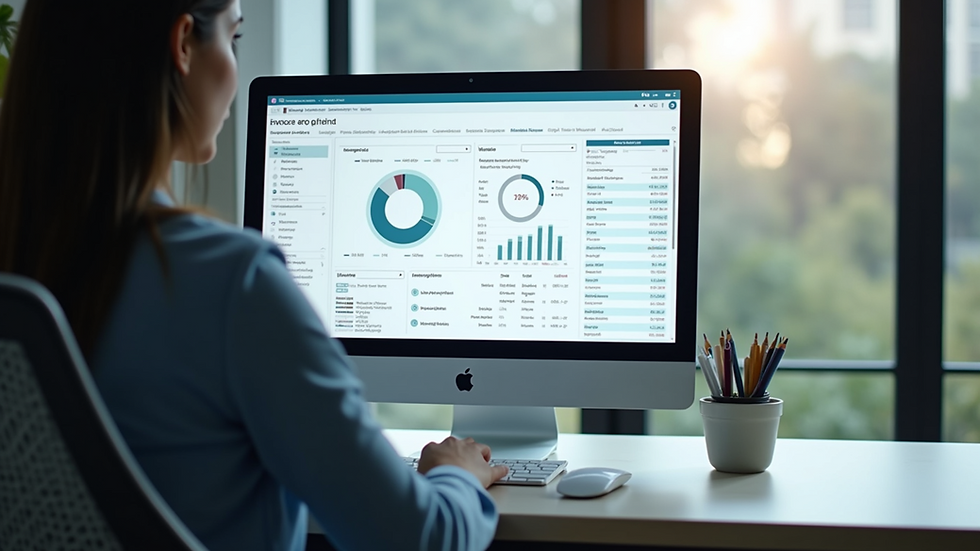Cut Expenses with Efficient Accounts Payable Management
- loriwilmsen24
- 5 days ago
- 4 min read
Managing accounts payable (AP) is a critical part of any business’s financial health. Yet many companies overlook how much they can save by improving this process. Inefficient accounts payable management leads to missed discounts, late fees, and cash flow problems. On the other hand, a well-run AP system cuts costs, strengthens supplier relationships, and frees up working capital.
This post explores practical ways to reduce expenses through efficient accounts payable management. You will learn how to identify common pitfalls, implement smart controls, and use technology to your advantage. Whether you run a small business or manage a large finance team, these insights will help you save money and improve your financial operations.
Why Efficient Accounts Payable Management Matters
Accounts payable refers to the money a company owes to its suppliers for goods or services received. Managing these payments efficiently affects your cash flow, credit rating, and overall profitability. Here are some reasons why focusing on AP can cut expenses:
Avoid late payment fees: Paying invoices late often results in penalties that add unnecessary costs.
Capture early payment discounts: Many suppliers offer discounts for paying invoices early, which can add up to significant savings.
Prevent duplicate or fraudulent payments: Poor controls can lead to paying the same invoice twice or falling victim to scams.
Improve cash flow forecasting: Knowing when payments are due helps you plan cash needs and avoid costly short-term borrowing.
Strengthen supplier relationships: Timely payments build trust and may lead to better terms or priority service.
By improving accounts payable, you reduce waste and make your business more financially stable.
Common Challenges in Accounts Payable
Before improving your AP process, it helps to understand common issues that cause inefficiency and extra costs:
Manual data entry errors: Typing invoice details by hand leads to mistakes that delay payments or cause incorrect amounts.
Paper-based processes: Physical invoices and approvals slow down the workflow and increase the chance of lost documents.
Lack of invoice matching: Without matching invoices to purchase orders and receipts, companies risk paying for goods not received.
Poor communication with suppliers: Unclear payment terms or unresolved disputes can delay payments and damage relationships.
Limited visibility: Without real-time tracking, finance teams struggle to prioritize payments or identify bottlenecks.
Addressing these challenges is the first step toward cutting expenses.
Steps to Improve Accounts Payable Efficiency
1. Automate Invoice Processing
Switching from manual to automated invoice processing reduces errors and speeds up approvals. Use software that can:
Scan and extract invoice data automatically
Match invoices with purchase orders and receipts
Route invoices for electronic approval
Store digital copies for easy retrieval
Automation cuts processing time by up to 80% according to industry studies, allowing your team to focus on exceptions rather than routine tasks.
2. Implement Clear Payment Policies
Establish and communicate clear policies around:
Invoice submission deadlines
Required documentation
Approval hierarchies
Payment terms and discount eligibility
Clear rules reduce confusion and ensure invoices move smoothly through the system.
3. Take Advantage of Early Payment Discounts
Many suppliers offer discounts for paying invoices before the due date, such as 2% off if paid within 10 days. Track these opportunities and prioritize payments to capture savings. Even a small discount can add up to thousands of dollars annually for larger companies.
4. Regularly Reconcile Accounts
Reconcile your accounts payable ledger with supplier statements monthly. This helps catch discrepancies early, avoid duplicate payments, and maintain accurate records.
5. Train Your Team
Ensure your finance staff understands the AP process, software tools, and fraud prevention techniques. Well-trained employees reduce errors and improve compliance.

Automated invoice processing dashboard showing payment status and alerts
How Technology Supports Cost Savings
Modern AP software offers features that directly reduce expenses:
Electronic invoicing (e-invoicing): Eliminates paper, speeds approvals, and reduces postage costs.
Payment scheduling: Automatically schedules payments to maximize cash flow and capture discounts.
Fraud detection: Flags suspicious invoices or duplicate payments before they are processed.
Supplier portals: Allow suppliers to submit invoices and check payment status, reducing inquiries and disputes.
Reporting and analytics: Provide insights into payment trends, outstanding liabilities, and discount opportunities.
For example, a mid-sized manufacturing company reduced late fees by 60% and saved $50,000 annually by adopting an AP automation platform.
Real-World Example: Saving Through AP Improvements
A retail chain with over 100 stores struggled with slow invoice approvals and frequent late payments. They implemented an automated AP system that:
Scanned and matched invoices automatically
Sent alerts for upcoming due dates and discount deadlines
Allowed managers to approve invoices on mobile devices
Within six months, the company cut late fees by 75%, captured $120,000 in early payment discounts, and reduced staff overtime. The improved process also freed up cash flow, enabling the company to invest in inventory.
Best Practices for Long-Term Success
To maintain efficient accounts payable management and ongoing cost savings:
Review and update payment policies regularly
Monitor supplier performance and renegotiate terms when possible
Conduct periodic audits to detect errors or fraud
Keep up with technology trends and upgrade systems as needed
Foster open communication between finance, procurement, and suppliers
These habits help your business stay agile and financially healthy.
Efficient accounts payable management is a practical way to cut expenses and improve your company’s financial stability. By automating processes, enforcing clear policies, and leveraging technology, you reduce errors, avoid fees, and capture valuable discounts. Start by assessing your current AP workflow and identify areas for improvement. Taking these steps will strengthen your cash flow and support your business growth.


Comments